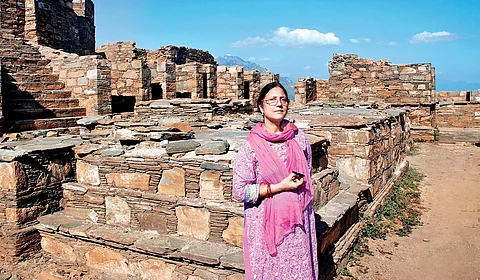

Author Sunita Dwivedi tells Medha Dutta Yadav about travelling and unravelling mysteries that talk of tarred highways, marauding armies, peace messengers, scholars, artists and more.
This book recreates the Buddha's journey. Tell us more.
The book recreates a journey on the Buddha's trail along the Lahore-Taxila-Peshawar-Kabul-Bamiyan-Balkh-Samangan route. These splendid cities were once centres of trade and scholarship. Their ruins today remind us of the glorious heritage of India.
My travels were aimed at experiencing first-hand the connectivity of Buddhist sites falling along this great heritage route running through northern India and the foothills of the Himalayas. The book gives an idea of Gandhara’s architectural wealth stored in the museums of Pakistan and Afghanistan.
You have written extensively on the Silk Road. What draws you?
I was fascinated by the story of the Silk Road. The myriad goods that were traded, of marvellous art that flourished, of faiths that travelled along the trade highways… I was amazed to find that Indian goods, traders, artisans were in great demand as far as the Caspian and the Black Sea. The travels undertaken by Chinese and Korean pilgrims to India between the fourth and eighth century CE also inspired me greatly.
Could you share some anecdotes while travelling and writing this book?
In Kabul my friends suggested that if I wanted to work undisturbed, I should cover myself. And so, whether I was in Kabul, going to the National Museum, or visiting the Bagh-e-Babur at Charbagh, or sitting on a charpoy over an icy stream at Paghman Darrah… I never ventured out without the cosy comfort of the burqa.
At the remote village of Aibak near Samangan I circumambulated the great stupa of Top-e-Rustam, along the pradikshana path as a Muslim, clad in a burqa. I explored every nook of the forsaken monastery of Aibak, unnoticed. But not everything was smooth-sailing.
At Kakrak valley, east of Bamiyan, I found a bunch of women tilling a potato field and making cow dung cakes. It prompted me take a couple of photos. No sooner had I clicked a few shots that a volley of stones was thrown at me and I had to quickly escape.
The one city in your journey that has stayed with you.
Bamiyan, because of its wondrous beauty, pleasant weather and architectural wealth. Even though the Buddha colossi are lost to the Taliban, there is much to see in the beehive of caves. Remnants of beautiful paintings and stucco figures can be traced.
The people are warm and friendly, the food delicious and the antique bazaars, especially the Titanic, is where you can spend hours looking at ancient carpets, coins and birch bark manuscripts.
What next?
My next work is yet another travelogue. It is based on the Buddhist cities lying along the Asian highway through Bangladesh. It involves a journey from the northern regions of Rajshahi right up to Cox’s Bazaar in Chittagong.
What are you reading right now?
Anton Chekhov’s ‘Grief’ from his collection The Stories.
Had you not been an author…
A teacher, for sure.
One book you could not finish?
Emily Bronte’s Wuthering Heights. I have read and re-read it, but still feel it is unfinished.